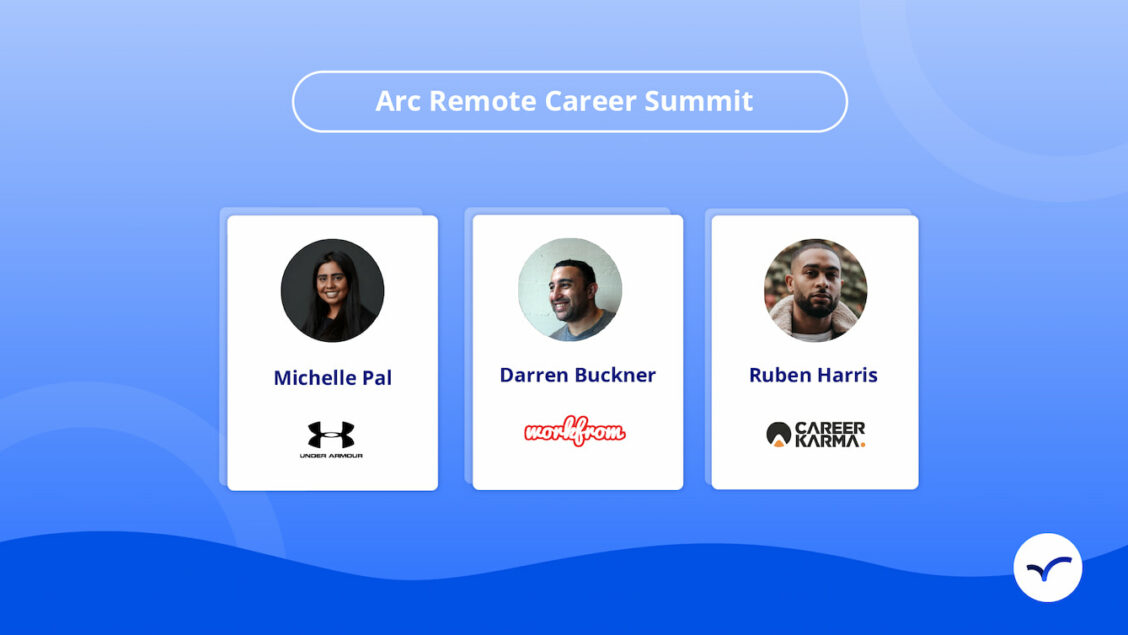One of the most exciting things about remote work is its focus on results-based performance, rather than focusing on time-based metrics. According to future of work experts, if all you’re measuring is performance, this opens the door to reduced bias in recruitment… or does it?
We wanted to hear from diversity and inclusion experts about their thoughts on remote work, and remote work during COVID-19. At the Arc Remote Career Summit, Joe Blair from Cota Capital lead a conversation with:
- Ruben Harris (CEO of Career Karma)
- Darren Bruckner (CEO of Workfrom)
- Michelle Pal (Talent and Operations Partner, Under Armour)
We encourage you to watch the video of this session below — but read on for a summary of some of the main takeaways!
Looking for top talent fast? See how Arc can help you:
⚡️ Find developers, designers, marketers, and more
⚡️ Freelance or full-time remote + fully vetted
⚡️ Save up to 80% with global hires
Hire top talent with Arc risk-free →
Don’t Rely on Traditional Credentials When Assessing Talent
Ruben discussed the fact that a lot of industries have de-facto expected credentials for entry:
A lot of times people use GPA or credit score as a judgment for your abilities.
However, these metrics are causing you to miss out on a lot of talent! Something that hiring managers need to grapple with — particularly in a more globalized world — is being able to measure the potential of future hires without relying on traditional credentials or “school brand.” It’s time to think deeper.
Take Responsibility to Educate Yourself
Michelle shared her previous experiences of colleagues asking her to teach them about diversity and inclusion (“teach me how to be woke”) — and how exhausting these requests can be.
We suggest starting with doing the work yourself: use the resources freely available online to find answers!
Understand that Lingo is Exclusionary
Remote work relies on strong communication skills. That said, if you haven’t been exposed to the “how we talk here” (or corporate lingo) before, this can be a barrier to diversity and success.
Ruben raised the fact that learning contextual language/lingo is hard enough verbally, but learning to do it in writing (even knowing which gif to drop into a Slack conversation) can be even harder.
Remote Work Can Revitalize Communities
Darren spoke positively about remote work’s potential as an equalizer:
I do think that removing location, you know, dependencies is how we get to more diverse teams and how we actually allow communities and individuals who can’t be at a location we’re locked out because they can’t be in a place. […] I think that it really has a huge opportunity to equalize in that way to bring dollars from other places into communities that certainly need it.
Remote Work is an Opportunity, Not an Answer
Michelle had a strong message for companies who think that remote work is a silver bullet for increasing diversity and inclusion:
If you’re using diversity as a reason to move remote, I think it’s really important to acknowledge that a remote setting is really only going to unlock the door as a company. You will actually need to put in the work to open the door and bring that diverse talent in. Otherwise you’re just gonna find the same, just not in your city.
Lean Into the Options Provided by Remote Work
Our panelists also discussed some of the benefits of working remotely:
- Use language in ways that are accessible to everyone, and understand that everyone has their own way of talking
- Use time zones to your advantage by having work happen around the clock with a global team (but also make sure you are respecting their time, and support them to set boundaries and available work hours)
- Allow people to consume information in different ways
Support the Whole Person
COVID-19 has ripped away the work/life divide, and when working remotely during a pandemic, there’s no ability to compartmentalize our lives to the same extent as before.
Something that team leaders need to grapple with is supporting the whole person: understanding their personal context and allowing them the space to figure out what works for them.
Understand that the Digital Divide Excludes Talent
Ruben reminded us that a) the digital divide is very real, and b) needs to be addressed by management:
You got to realize that, you know, most people got a smartphone, but a lot of people don’t have a laptop. Less than 60% of black and brown people actually have a laptop computer.
Remote work is inherently a digital way of working. Management needs to understand that there are large parts of the population who are at risk of being left behind — and actively plan how to address this.
Put Your Money Where Your Mouth Is
Aside from building the company infrastructure to support people to do their best work — wherever they are, and however they like doing it — the panelists challenged organizations to get real about hiring diverse talent. As Darren put it:
You write the check. You do what you have to do to make your team diverse. It’s intentional, you know — you don’t sort of back into it and just hope that it works. You don’t look for outside systems to, you know, create opportunities for you. You find the people and you hire them.
Likewise, Ruben pointed out that while donating to diversity-championing causes is great, organizations should also consider their own internal needs. If some of this money could be directed towards internal structural change, or salaries for new team members from diverse backgrounds, this is also well worth considering.
Michelle’s current workplace takes a strong line on diversity metrics: success in achieving these is directly tied to executive bonuses!
Make Diversity Measurable
Darren cut to the chase: aspirational diversity goals aren’t enough!
When it comes to diversity, he said, “what you focus on will improve.” By this, he means:
- Setting diversity metrics
- Measuring them, and
- Having real numbers and consequences behind them
Network and Champion Others
If you’re already in an organization, you can help champion diverse talent to both get hired and have career development. Ideas from our panelists include:
- Creating on-ramps for people to get into jobs
- Provide on-the-job training to get people to move beyond their initial roles
- Create projects that allow for diverse team members to be hired or take part
- Refer diverse talent to people with hiring power (remember that most jobs never appear on job boards!)
- Become an executive sponsor of employee resource groups
- Figure out how to actively build professional networks remotely, rather than relying on co-location, then use this to advocate for peers
Help Lead the Change
Although individual contributors don’t hold decision-making power at the executive level, there are still things that they can do to help create a more diverse and inclusive work environment. Michelle suggests finding a safe space or method to speak within your organization. Then, according to Darren:
Try to find your voice, try to find your power. And right now is your time to talk about this. Talk about it with your peers, but also go to your managers, go to folks who, you know, who are in positions of power, who have the ability to help with some of these things. Just be vocal.
He does note that a lot of people’s true values are being surfaced by these difficult and important conversations.
Ruben also pointed out that there are also a lot of organizations with well-meaning people who just don’t know what to do to help increase diversity and inclusion in the workplace. In these situations, it can be appropriate for a team member to step up and help guide the leaders make decisions, e.g. where to allocate diversity funds.
Wrapping Up
A big thank you to our panelists for an insightful conversation — and their challenges and actionable tips for business leaders everywhere. Also a thank you to Joe for hosting!
Thoughts? Questions? Let us know in the comments below.
You can also try Arc, your shortcut to the world’s best remote talent:
⚡️ Access 450,000 top developers, designers, and marketers
⚡️ Vetted and ready to interview
⚡️ Freelance or full-time








